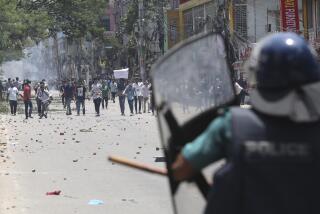Anxiety Grows in Phnom Penh With Rebels on March : Cambodia: The capital is reportedly back under curfew after the Khmer Rouge’s capture of a key town.
BANGKOK, Thailand — The government of Cambodia is reportedly reimposing a nighttime curfew in the capital of Phnom Penh, providing further evidence of anxiety over a string of recent guerrilla victories.
The Nation, a Thai newspaper, said in a dispatch from Phnom Penh that the curfew, a precautionary move, was ordered to begin at 9 p.m. Monday. The curfew comes in the wake of the Oct. 22 seizure of the western gem-mining town of Pailin by rebels of the Khmer Rouge.
The newspaper quoted a Cambodian government source as saying the curfew is intended to “hinder infiltrators’ movements and deal with them more effectively.”
The move could deal a serious psychological blow to the government of Prime Minister Hun Sen, which lifted a curfew in Phnom Penh only last spring after it had been in force for 10 years.
So far, no guerrilla attacks have been reported in the capital, although in early September, Khmer Rouge forces struck within 30 miles of the city, in Kompong Speu province. By all accounts, the city remains calm, and there has been no evidence of panic buying or other signs of crisis.
Still, the government evidently felt threatened by the guerrillas. The Khmer Rouge radio reported Saturday that its forces were advancing from Pailin along Route 10 toward the key provincial capital of Battambang.
The radio said that in fighting last week, the Khmer Rouge severed Highway 5 and a parallel rail link between Phnom Penh and Battambang, cutting Battambang off from reinforcements and supplies. At the same time, elements of two other rebel forces, the non-Communist Khmer People’s National Liberation Front and soldiers loyal to Prince Norodom Sihanouk, were also said to be advancing on the provincial capital of Sisophon to the northwest.
The government has made no mention of the fighting at Pailin for some time. It said Saturday that the national front forces had been repulsed near Svay Chek, which is about 20 miles north of Sisophon on Highway 69. It said the front lost 80 men in the fighting.
Western analysts have said they believe that the loss of either Battambang or Sisophon could be a crippling blow to the Hun Sen government, which is now hoping to persuade the United Nations to withdraw its recognition of the rebel coalition and hand the Cambodian U.N. seat back to the government in Phnom Penh.
The rebel forces apparently hope to use the captured area as the seat of a rival government. At present, they are based across the border in Thailand, where they have military camps and control about 300,000 refugees.
In a political sense, the Khmer Rouge offensive could backfire. It could cause some foreign governments to fear that the Khmer Rouge may be within reach of again seizing power in Cambodia.
The Khmer Rouge has been blamed for the deaths of more than 1 million Cambodians while in power from 1975 until 1978, when it was ousted by Vietnamese forces. If another Khmer Rouge takeover seemed imminent, some governments might throw their support to the Hun Sen administration simply to prevent another blood bath.
Ironically, the success of the rebel offensive is also lending some credence to Vietnam’s claim to have withdrawn the last of its forces from Cambodia on Sept. 26. The rebel groups have accused Hanoiof leaving behind a large contingent of Vietnamese troops in Cambodian uniform, but it seems unlikely that the rebels could have been so successful if Vietnamese troops were still present.
More to Read
Sign up for Essential California
The most important California stories and recommendations in your inbox every morning.
You may occasionally receive promotional content from the Los Angeles Times.









